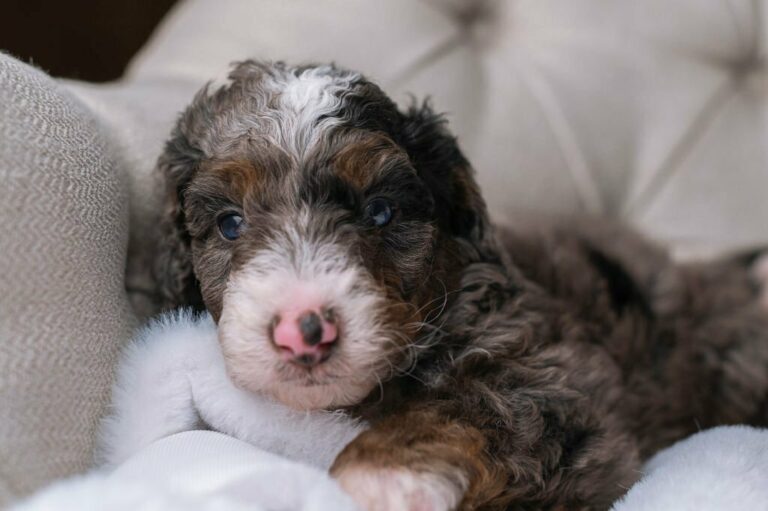Merle Bernedoodle: Merle Tri-color Bernedoodles Dog Breed
The Merle Tricolor Bernedoodle is a unique mix, famous for its Merle coat pattern that showcases a beautiful blend of colors. This F1 hybrid, created by pairing a Bernese Mountain Dog with a Poodle, gets the best of both worlds: the intelligence and low-shedding coat of the Poodle alongside the solid build and friendly demeanor of the Bernese.
These mini Bernedoodle dogs fit well into various homes due to their willingness to learn, which results in easier training sessions. Standard, mini, and toy varieties of the tri-color Bernedoodle are available to fit different living situations.
Potential rescue parents should look for responsible Bernedoodle breeders since mishandling the Merle gene could result in health problems.
Key Takeaways
- Merle Tricolor Bernedoodles boast a stunning color mix.
- These F1B doodle dogs inherit intelligence and low-shedding coats from their Poodle ancestry.
- Ethical breeding, especially by a professional Bernedoodle breeder, is paramount in avoiding genetic health issues.
The Merle Tricolor Bernedoodle stands out with its colorful coat. Being crossbred with acquired Poodle and Bernese traits, these tri-Bernedoodle puppies are intelligent and low-shed. Prospective owners should prioritize developing puppies for sale from breeding programs known for their ethical practices to prevent potential health complications.
Quick Facts
The Merle Tricolor Bernedoodle’s unique coat pattern combines diluted and full-strength color patches. This pattern comes from the merle gene the breed inherits from its parent dogs.
In these dogs, the merle gene works with other genes responsible for color to create a beautiful mix of white, black, and brown in their fur. The genetics behind this striking appearance are complex and involve different genes that dictate how color shows up and how intense it is.
Ethical breeding is vital to prevent health problems linked to the Merle gene and to keep these dogs healthy and thriving.
Merle Bernedoodle Pictures
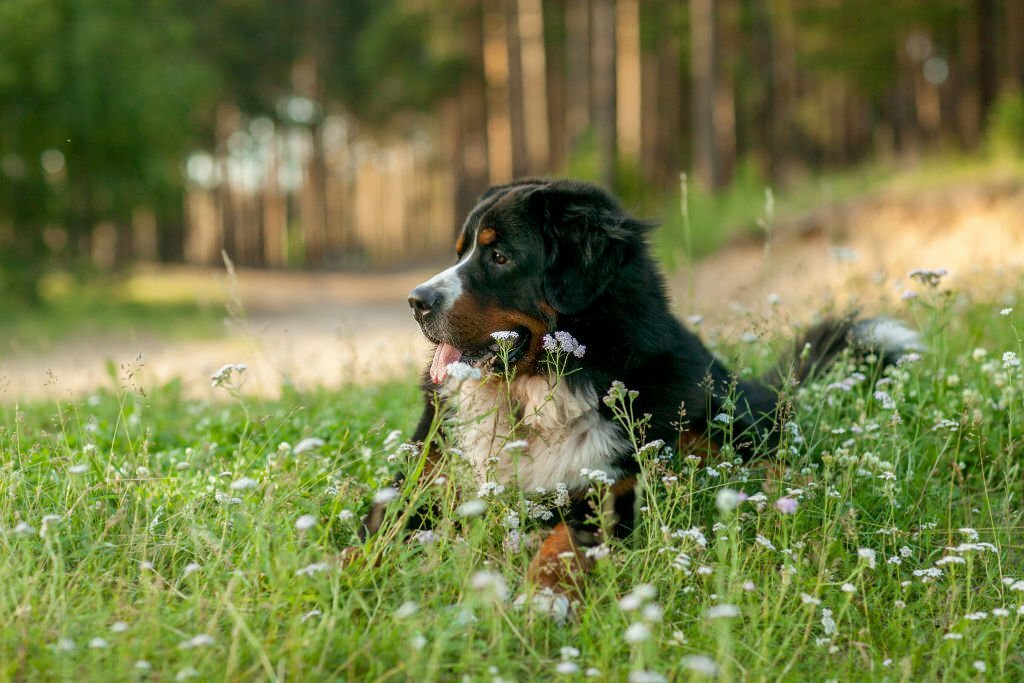
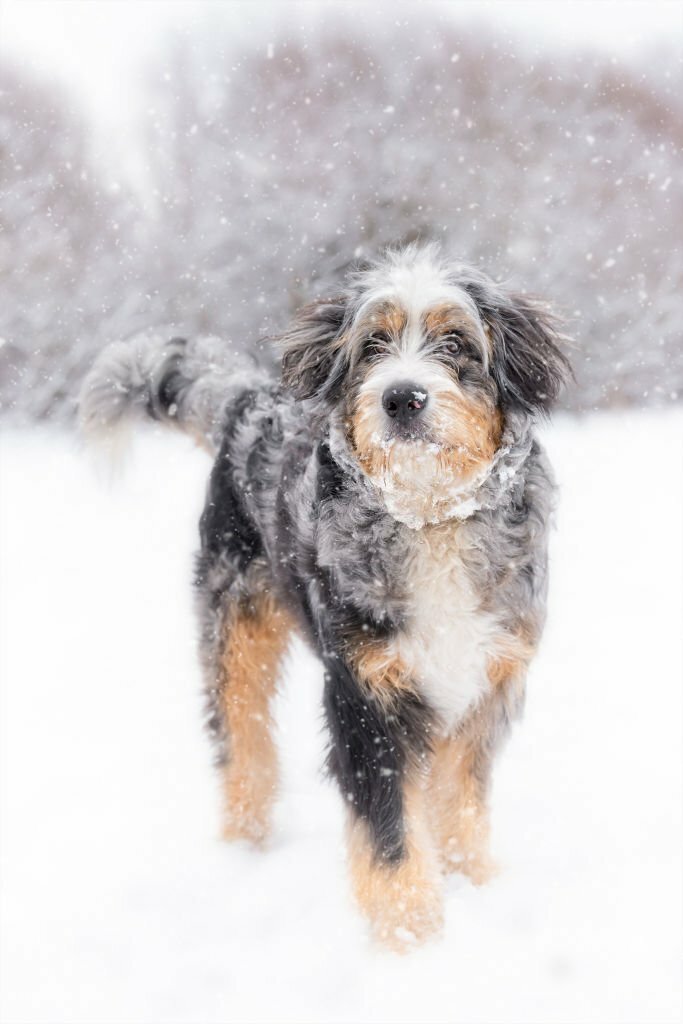
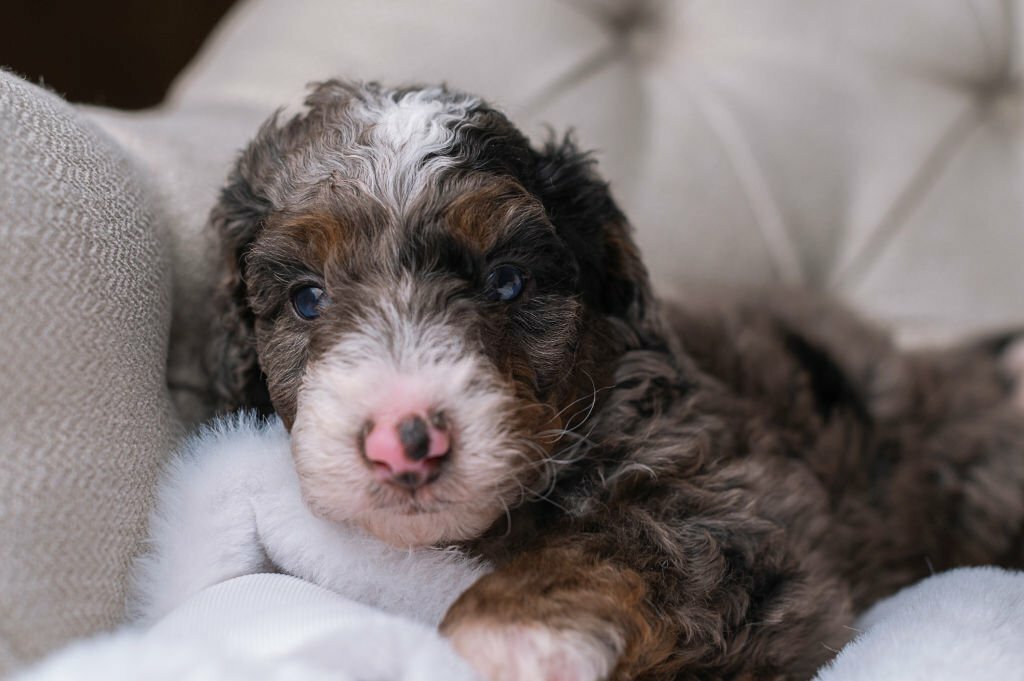
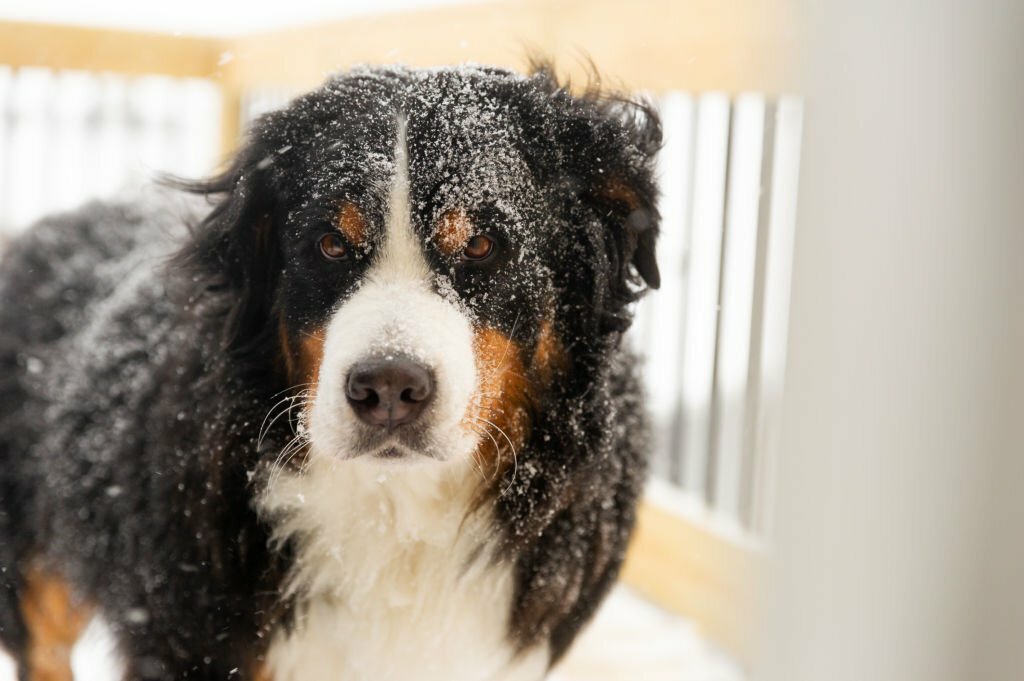

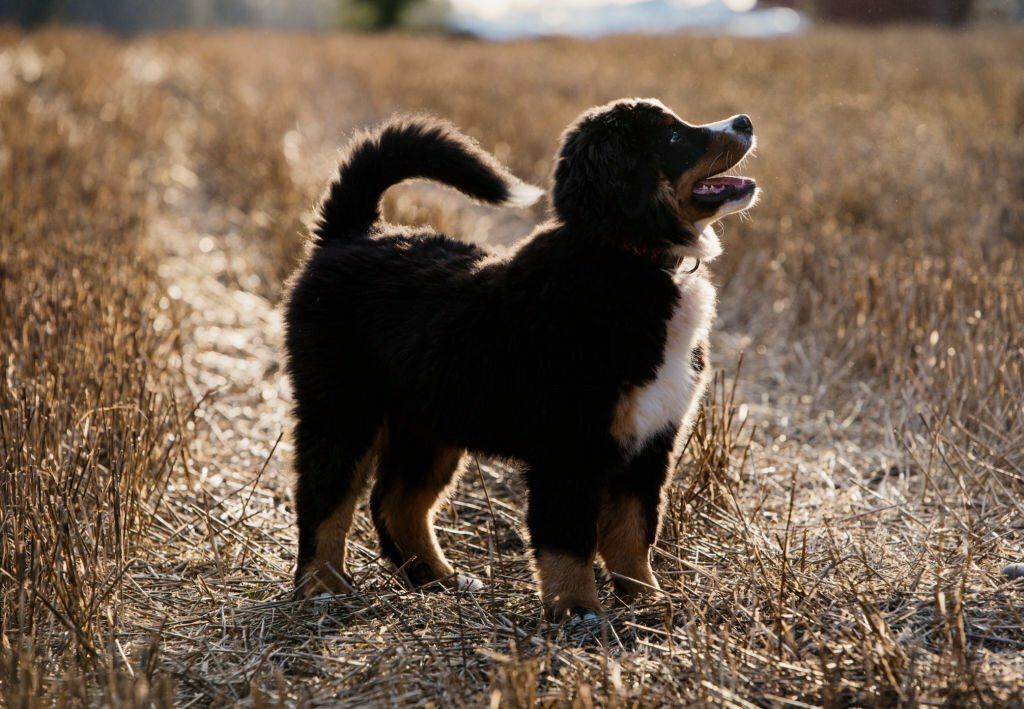
Overview of Tri-color Bernedoodles
The Merle Tricolor Bernedoodle is a stunning mixed breed that combines the traits of a Bernese Mountain Dog and a Poodle. Its eye-catching coat features a merle pattern that creates a beautiful mix of dark and light patches.
This pattern is due to a gene that lightens the dark base color, creating a unique, speckled effect. These dogs often have black, gray, or silver coats, complemented by patches of white and rust, reflecting their Bernese heritage.
The genetics behind their tricolor skin are fascinating and result from careful breeding practices. The appearance of the Merle Bernedoodle is visually appealing and sheds light on the exciting ways genes combine to create diverse physical traits.
Key Features
The Merle Tricolor Bernedoodle is a standout amongst the diverse coat patterns of Bernedoodles, known for its unique genetic makeup that presents a merle base intertwined with bold tricolor markings. This coat appearance, a product of genetic variations, features a diluted base color with patches of intense saturation, resulting in an eye-catching mottled look.
The tricolor pattern adds black, white, and tan layers, accentuating the merle effect and contributing to the coat’s intricate visual appeal.
| Characteristic | Description | Implications |
|---|---|---|
| Genetic Makeup | Merle base with tricolor markings | Distinct and varied coat colors |
| Coat Appearance | Reducing the risk of health problems | Striking visual impact |
| Health Considerations | Breeding practices to avoid merle-to-merle mating | Reducing risk of health problems |
Owning a Merle Tricolor Bernedoodle means having a dog that looks extraordinary and embodies a fascinating blend of genetics. Breeders and potential owners should be aware of specific breeding practices to prevent health issues; mating two merle-patterned dogs can lead to serious health risks for the puppies.
Breed Development History
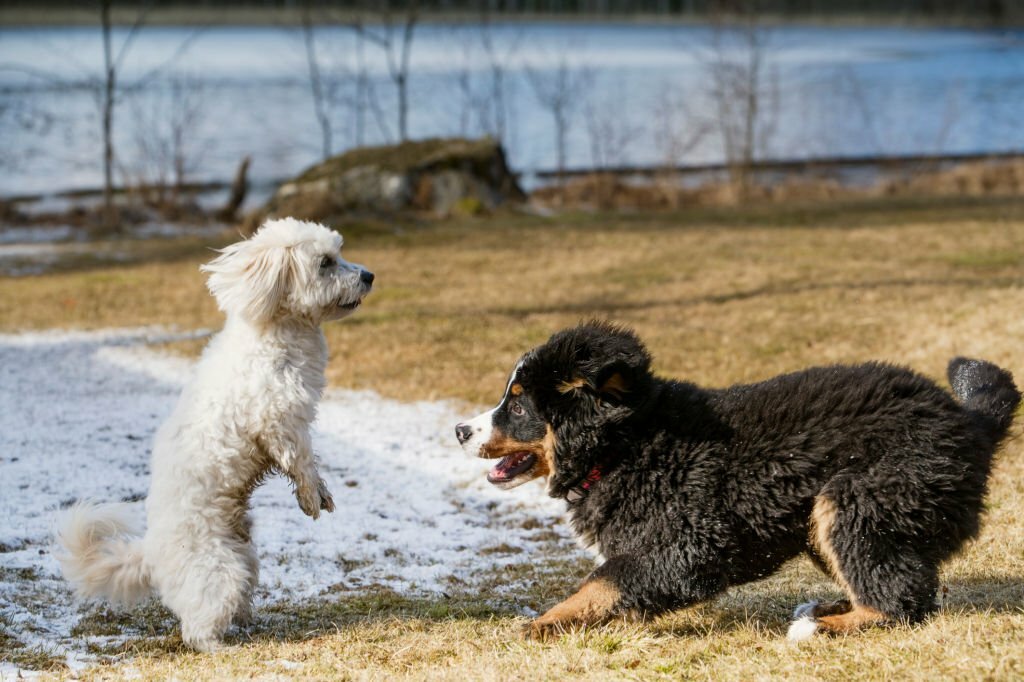
The recent development of the Merle Tricolor Bernedoodle marks a fascinating point in dog breeding. This new variety showcases the intricate blend of genetics from Poodles and Bernese Mountain Dogs.
DNA tests are crucial in tracing the merle gene back through the Bernedoodle’s history. The creation of the Merle Tricolor Bernedoodle results from specific breeding choices over time.
This process has combined the distinct features and behaviors of its parent breeds. Careful breeding practices are necessary to ensure the merle characteristic remains healthy in the Bernedoodle line.
It’s also vital to monitor the health of these dogs, as the merle gene can cause issues if not appropriately managed. Responsible breeding is critical to preventing health problems linked to the merle gene in Bernedoodles.
Genetic Lineage Tracing
Genetic lineage tracing has uncovered a detailed breeding strategy behind the unique appearance of the Merle Tricolor Bernedoodle. These dogs’ distinct mottled coat pattern is due to introduction of the Merle gene, foreign to their purebred ancestors, the Bernese Mountain Dogs and Poodles.
A Merle Poodle must be part of the genetic mix to achieve this pattern, showing deliberate crossbreeding efforts. Breeders have intentionally mated a Merle Poodle with a non-Merle Bernese Mountain Dog to maintain the breed’s signature white and tan markings while adding the Merle pattern variation throughout the Bernedoodle’s fur.
Crossbreeding Historical Timeline
The creation of the Merle Tricolor Bernedoodle began in the early 2000s to blend the eye-catching Merle coat pattern with the well-loved characteristics of the Bernese Mountain Dog. This designer dog is the offspring of carefully chosen Bernese Mountain Dogs and Poodles.
Breeders may have used a third dog breed known for this trait to introduce the merle coloration, which is not naturally found in the original species. Breeders conducted thorough DNA testing on the parent dogs to promote the merle color’s appearance while avoiding any genetic health issues that could arise from breeding two merle-patterned dogs.
This careful approach demonstrates the breeders’ focus on maintaining the health and beauty of these dogs.
Ancestral Breed Influences
When looking into the history of the Merle Tricolor Bernedoodle’s breed, the roles of its ancestors, the Bernese Mountain Dog and the Poodle, are pivotal. These breeds shape the dog’s behavior, physical characteristics, and health.
The Merle gene, responsible for the distinct color patterns, is not initially found in Bernese Mountain Dogs and is rare in Poodles. It may have been intentionally introduced through breeding or could be a rare mutation in the Poodle’s genetics.
Expert breeders use DNA testing to carefully breed for the sought-after phantom Tri-Color pattern while being mindful of the health issues that can come with the Merle gene. Understanding the genetic contributions of the Bernese Mountain Dog and Poodle helps maintain the Bernedoodle’s quality and health.
Height and Weight Range
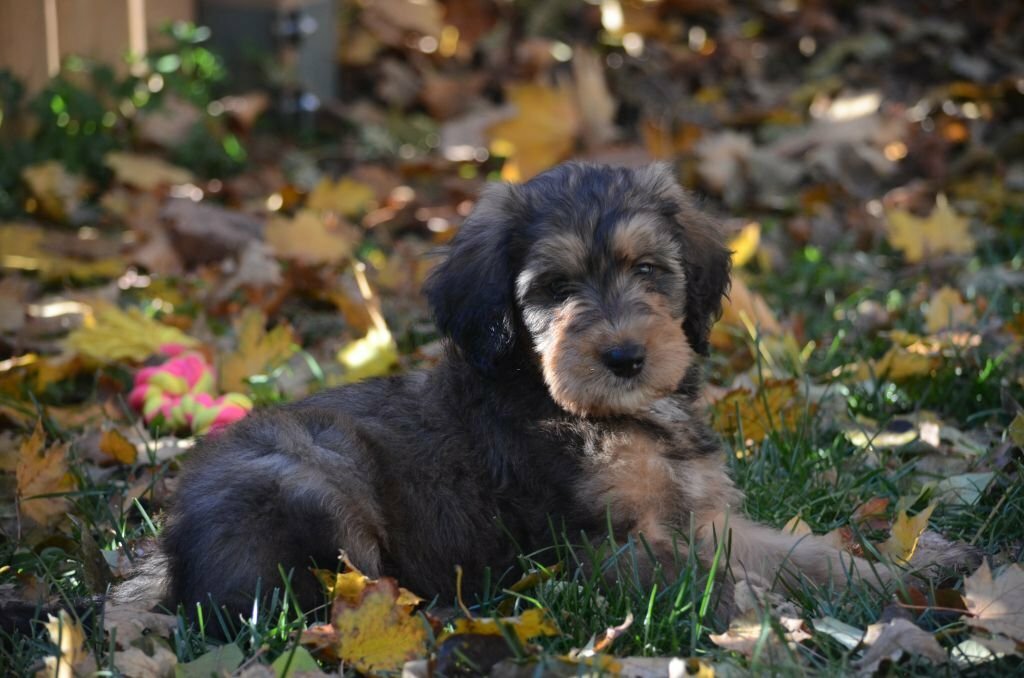
Knowing the height and weight range of a Merle Tricolor Bernedoodle is vital for anyone considering bringing one into their home. This knowledge helps you provide the best care and plan for their growth. The size of the Bernedoodle can vary, which means the expected length of an adult can differ.
That’s why having a growth chart to track their development is beneficial. Keeping an eye on your dog’s weight is also vital for their health and ability to move around comfortably.
Understanding the different sizes within the breed and the stages of puppy growth will help you make better choices for their diet and exercise needs.
- Typical Size for Adults
- Tracking Growth and Development
- Advice for Keeping a Healthy Weight
- Understanding Size Differences in the Breed
- Recognizing Stages of Puppy Growth
For each of these areas, consider the specific needs of your pet. A larger Bernedoodle will have different dietary requirements and exercise tolerances than a smaller one.
Regular vet visits and a balanced diet tailored to their growth stage are crucial for maintaining a healthy weight and preventing future health issues. Keep a close eye on their progress with a growth chart and adjust care as needed for their stage of life.
Average Adult Size
Merle Tricolor Bernedoodles usually range in height from 18 to 29 inches and tip the scales between 25 to 90 pounds. The size variation is influenced by the type of Poodle in their lineage, with standard, mini, and toy being common categories.
The mix of Bernese Mountain Dog and Poodle genes determines their size, which can also affect their behavior. For instance, a guide on Bernedoodle temperament indicates that a dog’s size could influence its exercise needs and how it interacts with its environment.
Knowing your pet’s ancestry helps predict their growth and assists in planning the right amount of physical activity.
Growth Chart Milestones
Growth chart milestones for a Merle Tricolor Bernedoodle vary widely depending on whether they’re a standard, mini, or toy size, a trait inherited from their Poodle relatives. Standard Bernedoodles tend to grow consistently, hitting more significant size milestones, while the growth of mini and toy Bernedoodles is more limited.
Tracking these milestones is vital for breeders and owners to ensure that the Merle Bernedoodle puppies are developing as expected. If growth patterns are off, it might be time to consult a vet for possible health issues.
Double Merle genetics can complicate growth expectations, making thorough and regular growth assessments even more critical.
Weight Management Tips
When you’re managing the weight of a Merle Tricolor Bernedoodle, it’s vital to customize their diet and exercise based on their specific size. A standard Bernedoodle’s adult weight usually falls between 70 and 90 pounds, and is about 23 to 29 inches tall at the shoulder.
Smaller varieties like the mini and toy will naturally weigh less. To keep your Bernedoodle at a healthy weight, monitor their eating habits closely and adjust their food portions according to their unique needs, including metabolic rate, life stage, and how active they are.
Keep them relaxed during meals to prevent them from eating too quickly and gaining extra weight. Regular physical activity is vital in maintaining a healthy weight. If you notice your pet is gaining weight, act quickly and get advice from a vet to ensure your dog stays on track.
Breed Size Variations
The size of Merle Tricolor Bernedoodles varies mainly due to their unique breeding history. Adult Bernedoodles can stand between 23 and 29 inches tall and usually weigh 70 to 90 pounds, placing them in the medium to large dog category.
This site is influenced by their Bernese Mountain Dog and Poodle ancestors. The striking Merle coat pattern that Bernedoodles can have does more than make them stand out; it also plays a role in their overall size.
Responsible breeding is critical to ensuring these dogs are healthy, especially considering the complex nature of Merle’s genetics. The tan points, a feature passed down from the Bernese side, enhance the Bernedoodle’s look, giving their build more definition and presence.
Puppy Development Stages
As a Merle Tricolor Bernedoodle puppy grows, its size and weight increase significantly, and these changes are carefully tracked. The growth of a Bernedoodle is influenced by the genes it inherits from its Bernese Mountain Dog and Poodle parents.
Puppies with a merle pattern and distinct white markings tend to grow at a rate similar to those with a single coat color. You’ll notice these puppies put on weight every week, but this weight gain slows down as they get closer to their full-grown size.
Different sizes like standard, mini, and toy Bernedoodles will grow at different speeds, so it’s essential to have breed-specific growth charts to know what to expect as they mature.
Temperament Traits
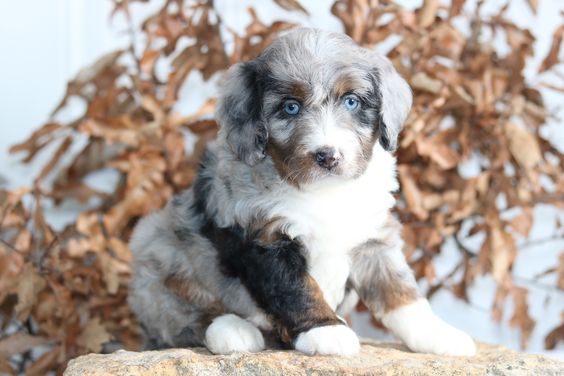
The temperament of a Merle Tricolor Bernedoodle combines its innate qualities with the environment in which it’s raised, shaping its unique personality. Owners must know how consistent the dog’s behavior is to ensure a good fit with their home life.
When considering a Bernedoodle, consider how well it adapts to family life and connects with everyone. When you’re looking at training a Bernedoodle, please pay attention to how quickly it picks up on commands.
Also, consider the dog’s energy levels to match your activity level and ensure you can provide enough exercise and mental challenges. Lastly, think about how much socialization the dog will need, both with people and other animals, to be a well-rounded pet.
Behavioral Consistency
Consistent training is crucial in shaping the behavior of a Merle Tricolor Bernedoodle. Thanks to their genetic makeup, these dogs are quick learners and respond well to training, mainly due to their inherited intelligence.
Good breeding has only enhanced these qualities, creating delightful companions inclined to follow commands. For these behaviors to become second nature, you must stick to a structured training routine.
Doing so ensures that the dog will react predictably to commands, which is fundamental in developing a dependable demeanor in your Bernedoodle.
Family Compatibility
Merle Tricolor Bernedoodles are known for their loving temperament and make excellent family pets. They get along well with people due to their friendly and calm nature.
When considering adding a Bernedoodle puppy to your home, it’s wise to look at how well they adjust and respond to learning new things. These dogs are intelligent, which helps them pick up on various commands and behaviors, making them an excellent fit for different types of families.
Giving them regular interaction with people and other animals is critical to helping them become well-behaved pets and avoid unwanted behaviors. Plus, Merle Tricolor Bernedoodles have an average need for exercise that suits most family routines, needing daily activities to keep them physically and mentally in good shape.
Training Responsiveness
Merle Tricolor Bernedoodles are known for their intelligence and willingness to please, making them excellent candidates for obedient training. These puppies are quick learners, quickly picking up new commands due to their sharp cognitive skills and friendly nature.
Positive reinforcement is a great way to tap into their love for praise, making them even more responsive to training. Keeping the movement consistent and repeating exercises is essential to ensure the behaviors stick.
These characteristics make Bernedoodles ideal for families looking for a trainable and well-behaved pet.
Energy Level Expectations
The Merle Tricolor Bernedoodle is known for its steady energy level, which makes daily physical activity a must for their health and behavior. This mixed breed dog, a cross between the strong Bernese Mountain Dog and the quick-witted Poodle, needs a good amount of exercise to stay happy and healthy.
Their need for physical activity is moderate, so a mix of different exercises can help prevent any behavioral problems and keep their mood balanced. Because the Merle gene can bring health issues, it’s essential to have regular veterinary check-ups to customize their exercise routine to their specific needs. This will help positively maintain the dog’s liveliness.
Social Interaction Needs
Social interaction is vital for developing Merle Tricolor Bernedoodle’s friendly and balanced nature. During their early life, it’s crucial to teach Bernedoodle puppies how to be sociable, which helps them become adaptable and easygoing.
Introducing them to various situations, people, and other animals is crucial in fulfilling their social engagement needs. These dogs love company and do best with frequent, positive interactions.
Careful socialization can prevent unwanted behaviors and strengthen their natural tendencies toward kindness and devotion. Meeting their social interaction needs is essential for fostering their naturally affectionate disposition.
Health Considerations
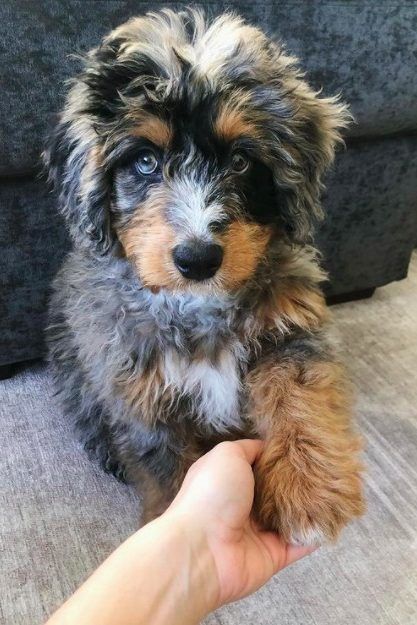
Potential pet owners looking into a Merle Tricolor Bernedoodle should be aware of specific health issues related to their unique genetic makeup. The merle gene, responsible for their distinctive coat, also brings a risk of hearing and vision problems.
These dogs need regular veterinary exams to catch and manage inherited conditions early on. Areas of lighter skin on these dogs may be more prone to skin sensitivities, which calls for attentive care.
Responsible breeding, including genetic testing, is critical to reducing the risk of such health concerns. Maintaining a proactive approach to health can lead to a longer and happier life for these dogs.
Preventive measures, such as a balanced diet and regular exercise, are fundamental for their physical and mental health.
Genetic Health Risks
When choosing a Merle Tricolor Bernedoodle, awareness of genetic health issues that come with their distinctive coat is essential. The merle gene creates beautiful patterns but poses a risk when two merle dogs are bred together, potentially leading to a double merle offspring.
This combination can significantly raise the chance of sensory problems, including deafness and eye abnormalities, due to reduced pigment, which is especially common in double merles. Breeders must be cautious and avoid mating two merle-patterned dogs to prevent these issues.
Pairing strategies should be informed by comprehensive genetic screenings to promote the well-being of Merle Tricolor Bernedoodles.
Lifespan Expectancy
Merle Tricolor Bernedoodles’ life expectancy typically falls between 10 and 15 years, but this can vary based on the level of care and consistent health check-ups they receive. It’s been observed that the health issues linked to the Merle gene, including hearing loss and eye problems, are heavily influenced by ethical breeding choices.
‘Bernedoodle: Everything You Need to Know’ stresses the value of genetic testing and choosing trustworthy breeders, found in a guide like ‘Top 10 Bernedoodle Breeders’ to lessen the chance of hereditary ailments.
Additionally, the guide ‘Bernedoodles: Important Details You Need’ highlights the importance of a preventive healthcare routine, with specific recommendations for diet, exercise, and regular vet visits to support the well-being and lifespan of these dogs.
Routine Veterinary Check-ups
Routine veterinary check-ups play a crucial role in maintaining the health of Merle Tricolor Bernedoodles. These dogs have a higher risk of health issues due to the Merle gene, and it’s particularly concerning if they inherit two copies of this gene.
Regular vet visits are essential to catch and treat hearing or vision problems early. A good breeder will give you a vaccination and screening plan for your new puppy.
Sticking to a schedule of health checks is vital. It helps spot problems quickly, allowing for timely treatment and a better chance at a healthy life for your Bernedoodle.
Maintenance Essentials
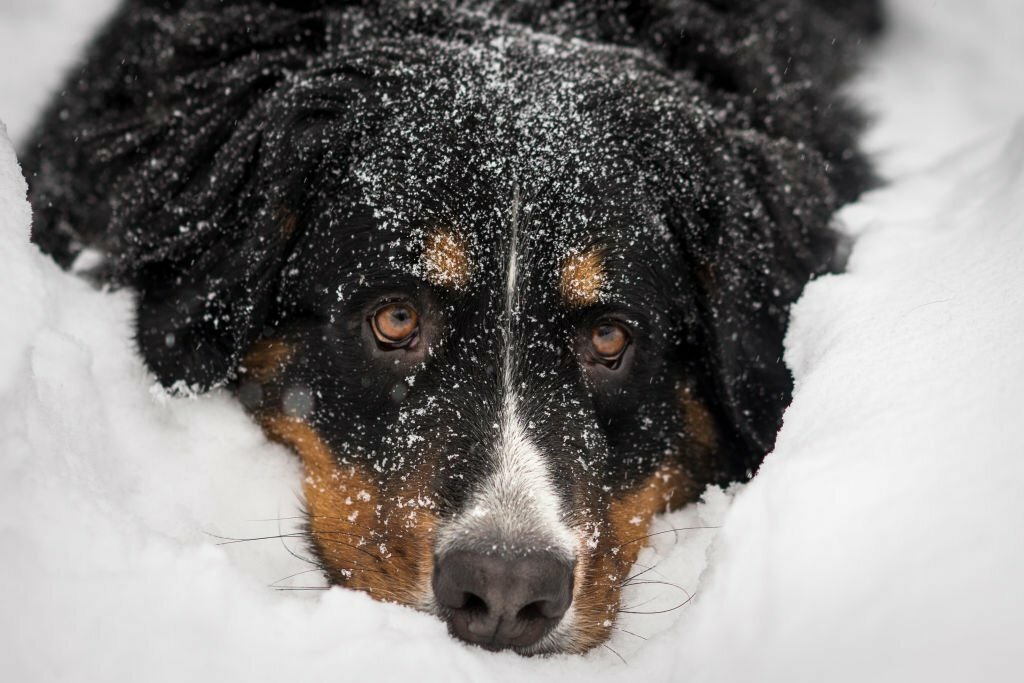
Caring for a Merle Tricolor Bernedoodle involves more than just regular walks and feeding. Proper grooming and healthcare routines are vital to keeping your pet healthy and happy.
- Brushing the coat every two weeks helps to reduce shedding and keep fur from matting.
- Use a mild shampoo made for this breed during their once-a-month bath to keep their skin and coat in good condition.
To avoid painful nail problems, trim their nails every two weeks. Weekly checks and cleaning of the ears are vital for preventing infections that can cause discomfort and hearing issues.
For dental health, brushing your dog’s teeth daily and giving them dental chews will go a long way in preventing oral diseases and ensuring they have a whole and happy life.
Brushing Frequency
Merle Tricolor Bernedoodles need a good brush at least once every three days to keep their beautifully patterned coat looking great. Their distinctive fur requires consistent care to prevent tangles and to keep their signature tricolor look sharp.
For anyone bringing home a Bernedoodle puppy, knowing how to care for their coat is vital for the dog’s well-being. Regular brushing keeps their coat smooth and spreads the skin’s natural oils, which are essential for preventing dryness and irritation.
Plus, while you’re grooming, you’ll get the chance to spot any skin problems early to get your pup the right help without delay.
Bathing Recommendations
When scheduling baths, caring for a Merle Tricolor Bernedoodle’s coat requires careful timing. You want to keep their coat clean and healthy without removing vital oils from their skin. How often you wash your Bernedoodle puppy depends on their activity, where they play, and their current fur state.
Too many baths could harm your dog’s skin, leading to irritation and possibly more skin infections. Breeders often advise bathing this breed every 4 to 6 weeks, adjusting as needed for your pup’s specific situation.
Using gentle, dog-appropriate shampoo will help keep their skin’s pH levels balanced and their fur shiny. A thoughtful approach to your Bernedoodle’s bathing routine is vital to keeping their distinctive coat in great shape.
Nail Clipping Schedule
Caring for your Merle Tricolor Bernedoodle’s nails is essential for their health and comfort. Neglecting to trim their nails can cause joint pain and even affect their walking posture.
Introduce your Bernedoodle puppy to nail clipping early to make it a routine part of their care. Typically, Bernedoodles need their nails trimmed every 3 to 4 weeks, though some may need it more or less frequently depending on how active they are and how fast their nails grow.
Keeping up with nail care is critical for the well-being of these lovely dogs.
Ear Cleaning Practices
Keeping your Merle Tricolor Bernedoodle’s ears clean is essential for their well-being, helping to prevent infections and ensure good hearing. Due to their floppy ears, these dogs are more prone to ear problems because the covered ear canal can easily retain moisture and promote bacterial growth.
Use approved ear-cleaning solutions for dogs to maintain your Bernedoodle’s ear health. It’s best to get your puppy used to ear cleaning from a young age to avoid stress. Gently put the key in their ears and massage the base to help break up earwax and debris.
After the solution works, carefully wipe away any loosened material with a soft cotton ball to prevent buildup that could lead to ear infections.
Dental Hygiene Tips
Taking good care of your Merle Tricolor Bernedoodle’s teeth is essential for preventing gum disease, which is common among dogs. Keeping up with oral care, such as regular brushing with toothpaste made specifically for dogs, is critical because the types meant for humans can harm your pet.
Giving them dental chews and toys is also beneficial and plays a role in controlling plaque. Before bringing a Bernedoodle into your home, it’s wise to learn everything about their care, including their dental health needs, similar to those of Goldendoodles.
Starting dental care routines early for Bernedoodle puppies is vital, as it sets the stage for avoiding dental issues as they grow.
Dietary Requirements
Caring for the dietary needs of Merle Tricolor Bernedoodles is essential for their well-being. Their diets must be customized to their unique requirements, taking into account variables like age, weight, and how active they are.
Designing a diet that avoids allergens and setting regular meal times are crucial to keeping them healthy and happy. A balanced diet for these dogs includes the right mix of proteins, fats, carbs, vitamins, and minerals to support their bodily functions.
It’s also vital to recognize which ingredients could cause allergic reactions and steer clear of them. Regular feeding schedules help with digestion and prevent weight gain.
High-quality, breed-specific food or well-planned homemade meals will provide the necessary nutrition. Don’t forget about hydration; ensure your Bernedoodle always has access to clean water.
Nutritional Needs
Proper nutrition is vital for the health and well-being of Merle Tricolor Bernedoodle. These dogs need a balanced diet that provides enough protein, fat, and carbohydrates to keep up with their energetic nature.
Since they hail from breeds known for their vigor, Bernedoodle puppies require carefully planned meals to support their growth and development. Proteins are the building blocks for their muscles and tissues, and fats offer a dense energy source while helping to absorb vitamins.
Carbohydrates are another form of energy and support digestive health. It’s also wise to tailor their diet to address inherited health issues related to the merle gene.
Regular check-ups with a vet are crucial to ensure their diet is on track and to make necessary adjustments as the dog grows. This approach helps maintain the breed’s distinctive vitality and reduces the risk of genetic health problems.
Food Allergies Management
Managing food allergies in Merle Tricolor Bernedoodles involves creating a diet that avoids allergens and supports their distinct genetic traits. These dogs can inherit characteristics from their Poodle and Bernese Mountain Dog parents, sometimes including food sensitivities.
To manage these issues, breeders and owners must work together. They use genetic testing to pinpoint potential allergens and avoid them.
A well-thought-out plan is essential to prevent allergic reactions that could harm the dog’s health. Diets that include unique protein sources and hydrolyzed proteins may help these dogs by providing the nutrients they need without causing allergic reactions.
Regular check-ups with a vet are vital to keeping an eye on the dog’s health and adjusting their diet as needed to ensure they stay healthy and happy.
Feeding Schedule Importance
Creating a regular feeding routine is vital for Merle Tricolor Bernedoodles to ensure they get the proper nutrition for their specific needs. These dogs have unique dietary requirements that must be carefully balanced to promote their growth, support cellular function, and reduce health issues linked to their merle gene.
A well-thought-out feeding plan includes precise timing and amounts of food, which helps maintain their beautiful tricolor coat, keeps their energy levels up, and strengthens their immune system. Adjusting meal sizes and frequency to fit their age and how active they are can help your Bernedoodle maintain a healthy weight and enjoy a fulfilling life.

